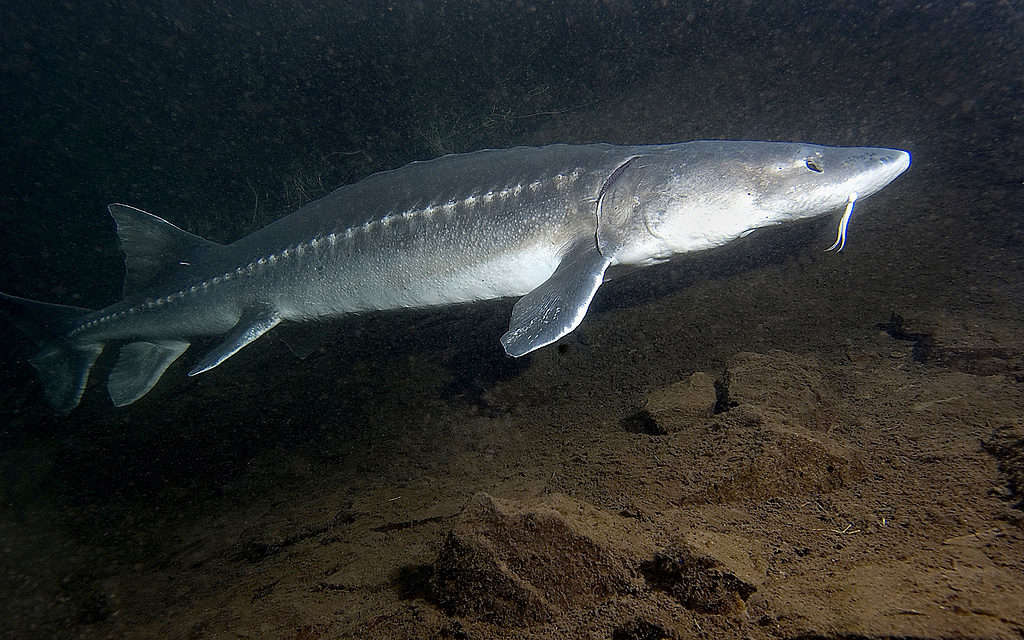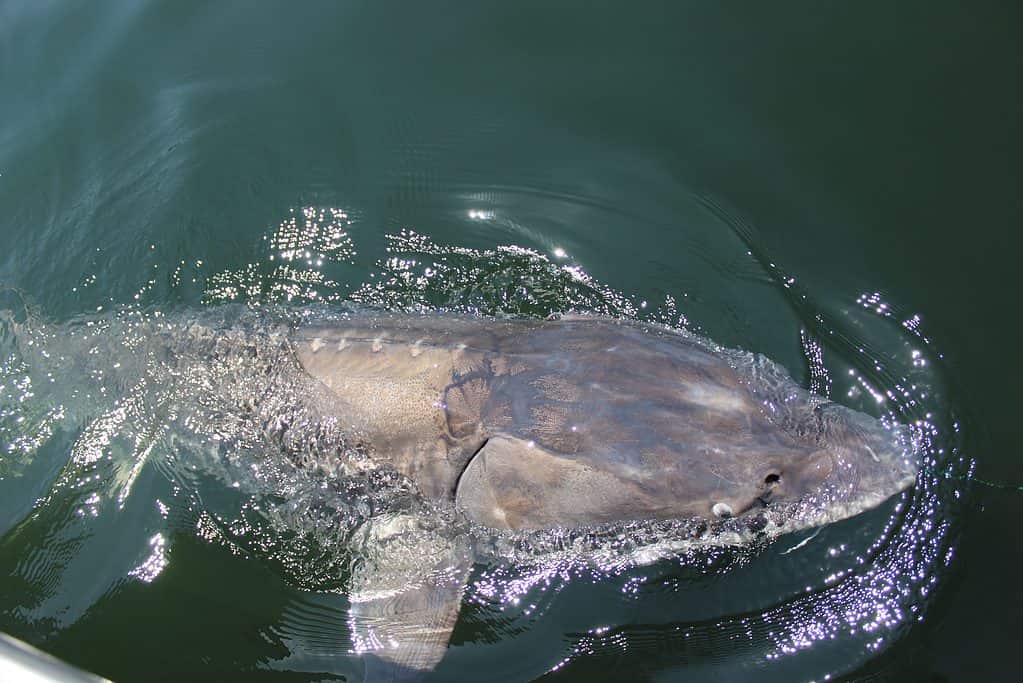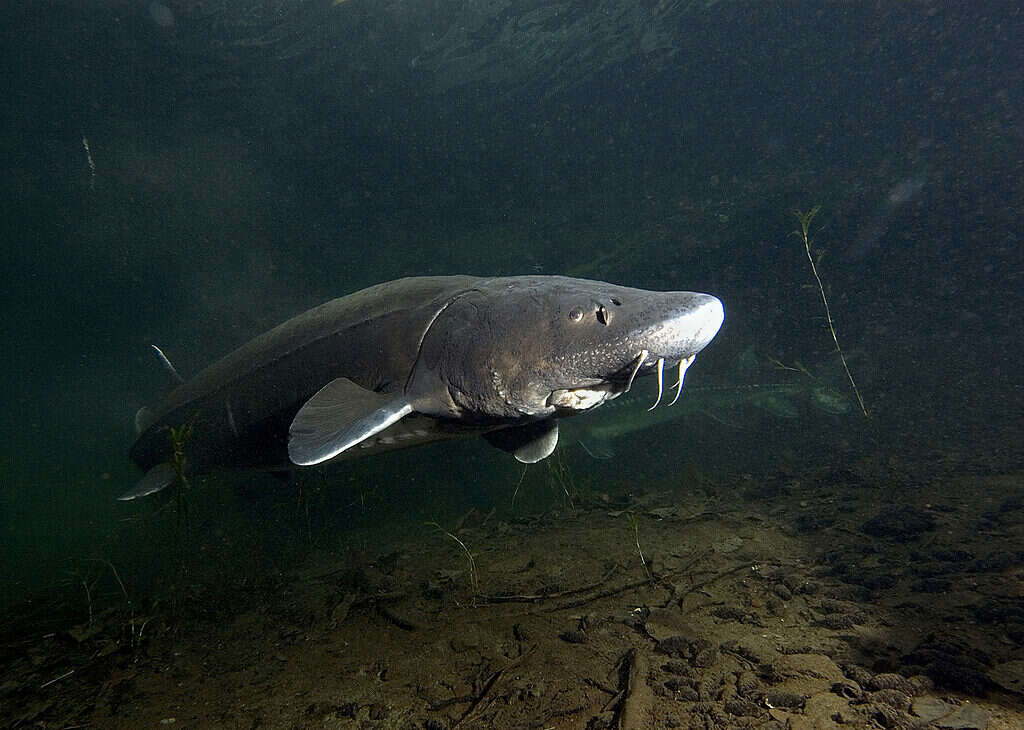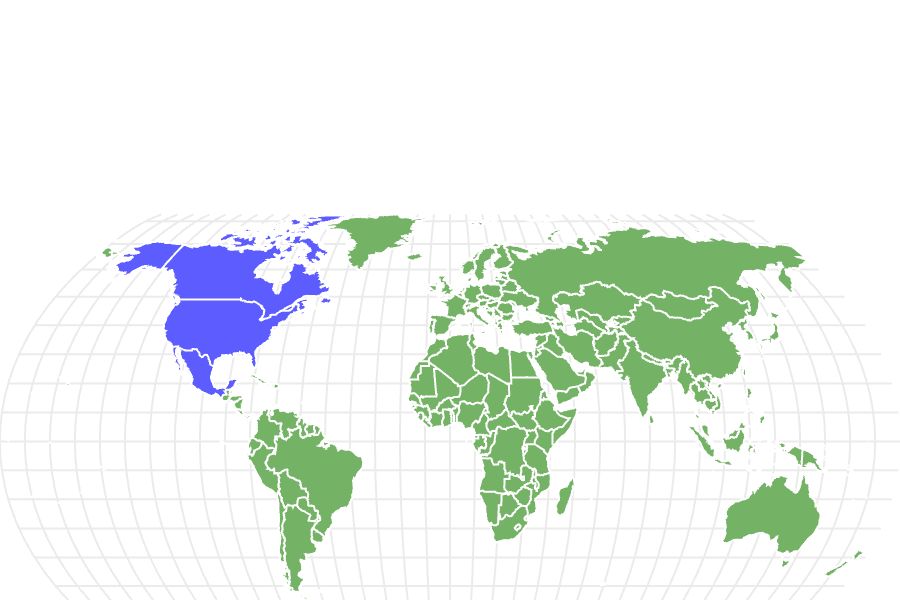They don't have any teeth!
Advertisement
White Sturgeon Scientific Classification
- Kingdom
- Animalia
- Phylum
- Chordata
- Class
- Actinopterygii
- Order
- Acipenseriformes
- Family
- Acipenseridae
- Genus
- Acipenser
- Scientific Name
- Acipenser transmontanus
Read our Complete Guide to Classification of Animals.
White Sturgeon Conservation Status
White Sturgeon Facts
- Prey
- Other fish like salmon, flounder, and herring, crab, shrimp, clams, lamprey, barnacles, mussels, crayfish
- Name Of Young
- Fry
- Group Behavior
- School
- Fun Fact
- They don't have any teeth!
- Biggest Threat
- Overfishing
- Average Spawn Size
- 400,000 to 4 million
- Diet
- Omnivore
- Common Name
- Oregon sturgeon, Pacific sturgeon, Sacramento sturgeon, Columbia sturgeon
- Special Features
- No teeth, taste buds outside their mouths
- Number Of Species
- 1
- Group
- Ray-finned fish
White Sturgeon Physical Characteristics
- Color
- Brown
- Grey
- White
- Skin Type
- Boney Plates
- Top Speed
- 1.41 mph
- Age of Sexual Maturity
- 15-25 years
- Aggression
- Medium
View all of the White Sturgeon images!
The white sturgeon (also called the Oregon, Sacramento, Pacific, or Columbia sturgeon) is a massive, prehistoric fish that can survive in both freshwater and saltwater environments. Though it’s a popular sport fish due to its size and tasty meat, most regions have strict regulations to prevent overfishing. This sharklike fish has survived on Earth for hundreds of millions of years, but its infrequent reproduction means it recovers from population losses very slowly.
White Sturgeon Fish Facts
- Largest North American freshwater fish: The white sturgeon is North America’s largest freshwater fish and one of the largest freshwater fish in the world, growing up to 20 feet long and weighing as much as 1,800 pounds!
- No teeth: Despite their intimidating appearance, this species doesn’t have any teeth. Instead, it sucks its prey into its mouth and swallows it whole.
- Taste buds on the outside of their mouths: Unlike most fish, this species has taste buds outside its mouth, not inside. This helps it decide which prey to consume.
- Often mistaken for a shark: White sturgeon look sharklike with their scaly bodies and unbalanced caudal fins, but in reality, the two aren’t closely related.

The white sturgeon doesn’t have any teeth, instead it sucks its prey into its mouth and swallows it whole.
©Oregon Department of Fish & Wildlife, CC BY-SA 2.0 <https://creativecommons.org/licenses/by-sa/2.0>, via Wikimedia Commons – License
White Sturgeon Classification and Scientific Name
The scientific name for the white sturgeon is Acipenser transmontanus. Acipenser means “sturgeon,” trans means “beyond,” and montanus means “mountain.” Scientists classify them as bony fish, which means their skeletons are made of bone.
This species belongs to the class Actinopterygii within the order Acipenseriformes and the family Acipenseridae. Any of the 27 species of fish within this family may go by the common name sturgeon. The white sturgeon’s genus, Acipenser, is the largest of its order, containing 17 species of fish. The other three genera are Huso, Scaphirhynchus, and Pseudoscaphirhynchus.
White Sturgeon Appearance
White sturgeon are not predominately white as their name suggests. Rather, their dorsal region (upper body) is greyish or brownish while their ventral region (underside) is white. Their fins are grey and include the dorsal, anal, pelvic, and pectoral fins. Instead of scales, they have two rows of four to eight scutes (bony plates). Four barbels around their mouths help them sense prey in the water.
Though this fish appears sharklike, it is not closely related to sharks. The misconception often arises because of its heterocercal tail, which is a caudal fin with a longer top lobe than bottom lobe. Though it has a large mouth, it has no teeth, relying on suction to entrap its prey.
Adult white sturgeon typically weigh between 990 pounds to 1,500 pounds. They range in size from five to 14 feet in length once they reach sexual maturity. However, the longest individual ever caught was just over 20 feet long while the heaviest weighed just shy of 1,800 pounds.

The white sturgeon is one of the largest freshwater fish in the world, growing up to 20 feet long and weighing as much as 1,800 pounds!
©Leah.Zastrow/Shutterstock.com
White Sturgeon Distribution, Population, and Habitat
The white sturgeon inhabits bodies of fresh water and saltwater in the following countries:
- The United States (along the Pacific Coast from the Gulf of Alaska to California)
- Canada
- Mexico (along the Pacific Coast)
In the United States, these fish mainly inhabit Alaska Bay, Washington, Oregon, and California, though northwestern Montana has limited populations. Within Canada, they solely inhabit the coastal province of British Columbia. In Mexico, they can be found in states such as Baja California. They largely inhabit the Fraser River in British Columbia, the Columbia River and its tributaries in Washington and Oregon, and the Sacramento-San Joaquin system in California.
Though they spend much of their time in marine environments, white sturgeon swim through estuaries where the river meets the sea in order to move upriver. They do this in early spring to spawn. However, some populations are landlocked, such as those in the Columbia River in Montana and Lake Shasta in California. Scientists have found members of this species living at depths of up to 400 feet.
The number of white sturgeon has declined since 2004 when the IUCN listed them as Least Concern. In 2020, they changed their status to Vulnerable. The WWF lists sturgeon in general as the “most endangered species group on earth.” See a list of endangered animals here.
White Sturgeon Evolution and History
Though fish first appeared on earth approximately 500 million years ago, prehistoric ancestors of the white sturgeon date back about 175 million years. This fish likely evolved from an extinct order of fishes called Palaeonisciformes, which existed near the end of the Silurian Period about 419 million years ago. This was an early order of ray-finned fishes belonging to the class Actinopterygii. Modern white sturgeon belong to the same class in the order Acipenseriformes.
The only two surviving families in the order Acipenseriformes are Acipenseridae (sturgeon) and Polyodontidae (paddlefishes). Only two species of paddlefish exist today. The two families diverged from other groups of ray-finned fishes about 300 million years ago. Though they are related, sturgeon and paddlefish diverged from each other during the Jurassic Period between 208 and 146 million years ago. The ancestors of white sturgeon lived during the time of the dinosaurs, as long ago as the Early Jurassic Epoch. The first fossils date back to the end of the Early Jurassic or the beginning of the Middle Jurassic, about 175 million years ago.
Sturgeon thrived in the Cretaceous Period between 145 and 66 million years ago, eventually splitting off into today’s 27 extant species. Several species have already gone extinct with more in danger of suffering the same fate. White sturgeon today closely resemble prehistoric versions with their bony plates and heterocercal tails. The lack of drastic change in these “living fossils” may be due to an absence of predation and their ability to adapt to different temperatures and salinities. They likely evolved barbels around their mouths due to their poor eyesight; these barbels help them locate food along murky riverbeds.

White sturgeon today closely resemble prehistoric versions with their bony plates and heterocercal tails.
©Oregon Department of Fish & Wildlife, CC BY-SA 2.0 <https://creativecommons.org/licenses/by-sa/2.0>, via Wikimedia Commons – License
White Sturgeon Predators and Prey
White sturgeon are carnivores, surviving entirely on animal matter. Due to their size, they have ample dietary choices. Though they often eat other fish, they also feed on smaller prey, including insect larvae. In terms of predators, this species has little to worry about, at least once reaching adulthood. Their bony plates also help protect them. However, even fully grown fish may be at risk from a very small group of predators.
What Eats White Sturgeon?
As juveniles, these fish face predation from larger fish, including smallmouth bass, walleye, and salmon. They may also be the target of various species of sharks. Occasionally, adult white sturgeon even prey on younger, smaller members of their own species. Fish eggs are especially vulnerable to predation.
Due to their massive size, adults of this species have few natural predators. Humans present the biggest threat to their existence through overfishing. Some sharks occasionally prey on this fish, especially the tiger shark. Lampreys may also successfully latch onto their bodies and cause them serious harm.
What Do White Sturgeon Eat?
Adult white sturgeon are big enough to eat other fish, including salmon, herring, and flounder. They also eat shrimp, lamprey, clams, crabs, barnacles, mussels, and crayfish. Smaller individuals may choose to settle for fish eggs, insect larvae, and snails.
White Sturgeon Reproduction and Lifespan
White sturgeon reproduce slowly, sometimes only spawning once every few years. Both sexes reach sexual maturity relatively late, males by the age of 15 years and females by the age of 20. Like most fish, they lay eggs instead of bearing live young.
In preparation for spawning, these fish move upriver from the ocean in early spring in search of fast-moving waters between 57 and 64 degrees Fahrenheit. Once they find a suitable location, the females release eggs directly into the current. Depending on her size, each female can release between 400,000 and four million eggs at one time. This helps make up for infrequent spawning. The males swim next to the females and simultaneously release their milt (sperm) into the current. Fertilization only occurs in a small portion of the eggs.
The sticky eggs eventually sink to the bottom of the river, where they adhere to surfaces like rocks and logs. This makes it more difficult for predators to find them. They incubate for anywhere between five and 25 days, depending on the water temperature; colder water means a longer incubation period. The eggs hatch to release larvae, which are approximately a quarter of an inch in length. Attached yolk sacs provide nutrition for the first 12-14 days, after which the juvenile sturgeon will begin to hunt for other sources of food.
Larvae sturgeon are weak swimmers due to their small size and yolk sacs. Eventually, they instinctively spread out by allowing the current to take them downstream, providing predators with a less concentrated food source. By about 50 days after hatching, sturgeon fry look like tiny versions of their adult selves, complete with barbels and scutes. This species can live to be over 100 years old under optimal conditions, though most individuals do not make it this long.
White Sturgeon in Fishing and Cooking
White sturgeon made excellent sport fish as well as a tasty dish. Read on to find out how to catch and prepare this unique species.
Fishing for White Sturgeon
White sturgeon are popular with recreational fishermen, though most regions have strict laws regulating the practice. In some areas, it is illegal to fish for this species as its infrequent spawning renders it susceptible to overfishing. The best time to catch them is between March and October.
Most anglers catch white sturgeon with either a gillnet or traditional bait and hook. Experts recommend using live bait as artificial lures are not typically successful. Some of the best forms of live bait are dead salmon, herring, smelt, trout, or squid. As this species searches along the bottoms of rivers for food, it’s best to keep the bait as low in the water as possible. When hooked, white sturgeon often jump out of the water and fight for prolonged periods of time.
Commercial fishing of white sturgeon has variously increased and decreased over the years due to concerns about overfishing. In 1917, for example, the state of California shut down a commercial fishery that began in the late 1800s due to a steeply declining population. Today, only recreational fishers may catch members of this species in the state. In some sections of the Columbia River, which runs through Washington and Oregon, the government permits commercial fishing for white sturgeon with size restrictions. These restrictions make it unlikely that fisheries will retain females large enough to produce eggs, which are extremely valuable as caviar. In the Fraser River in British Columbia, Canada, anglers may catch these fish provided they release them afterward. To protect vulnerable populations, the government prohibits commercial fishing in the province.

Overfishing has put white sturgeon at risk so many regions have enforced restrictions such as catch and release rules.
©CSNafzger/Shutterstock.com
Cooking and Eating White Sturgeon
When it comes to cuisine, this species is renowned for its quality and versatility. It has a firm, meaty texture that appeals to chicken and beef lovers. Though wild specimens have an earthy flavor, farmed white sturgeon is milder. This type of fish is especially popular in the United States, Canada, and Russia, while its caviar is prized in the United States and Europe.
Acceptable cooking methods for this species include broiling, grilling, baking, steaming, sautéing, and smoking. Due to its relatively low fat content, it’s wise to either brush the meat with oil or melted butter or else cook it in oil or sauce. Check out this guide to steaming, baking, or sautéing sturgeon as well as this recipe for vinegar-poached sturgeon.
Merchants usually sell white sturgeon as fillets and steaks. A six-ounce portion has approximately 180 calories, 27.6 grams of protein, and 6.9 grams of fat. Take a look at the rest of the nutritional information here as well as a guide to filleting sturgeon.
Related Animals
View all 108 animals that start with WWhite Sturgeon FAQs (Frequently Asked Questions)
Where are white sturgeon found?
White sturgeon are found along the Pacific Coast of the United States, Canada, and Mexico. They are capable of living in marine environments, which they leave to enter river estuaries in order to spawn.
Are white sturgeon endangered?
As of 2020, the IUCN lists white sturgeon as Vulnerable. This is a change from 2004, when the organization classified them as Least Concern.
How old is the oldest white sturgeon?
The oldest white sturgeon on record was 103 years old.
Are white sturgeon sharks?
No, white sturgeon are not sharks despite their appearance and size.
Are white sturgeon good to eat?
White sturgeon are excellent fish to cook and eat. Some people eat them raw, claiming that amplifies the flavor. See our “White Sturgeon in Fishing and Cooking” section to find out more about preparing this fish.
Thank you for reading! Have some feedback for us? Contact the AZ Animals editorial team.
Sources
- Fish Base, Available here: http://www.fishbase.us/summary/SpeciesSummary.php?ID=2594&AT=white+sturgeon
- Red List, Available here: https://www.iucnredlist.org/species/234/97440736
- Seafood Source, Available here: https://www.seafoodsource.com/seafood-handbook/finfish/sturgeon
- WWF, Available here: https://wwf.panda.org/discover/our_focus/freshwater_practice/freshwater_inititiaves/sturgeon_initiative/
- Britannica, Available here: https://www.britannica.com/animal/sturgeon-fish
- Nechako White Sturgeon Recovery Initiative, Available here: https://www.nechakowhitesturgeon.org/sturgeon/School_Curriculum/Curriculum%20Package%20ORIGINAL/Sturgeon%20Life%20Cycle/Life%20cycle%20of%20the%20white%20sturgeon%20copy.pdf
- Kidadl, Available here: https://kidadl.com/facts/animals/sturgeon-facts
- Our Everyday Life, Available here: https://oureverydaylife.com/540132-how-to-cook-sturgeon-fillets.html
- Food & Wine, Available here: https://www.foodandwine.com/recipes/vinegar-poached-sturgeon-thyme-butter-sauce
- Chef's Resources, Available here: https://www.chefs-resources.com/seafood/finfish/sturgeon/

















